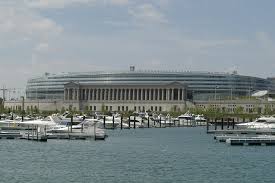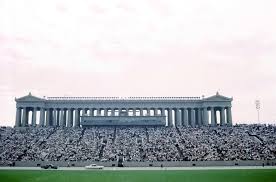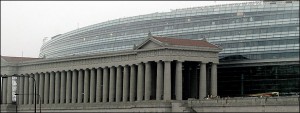By John Sullivan
“Monstrosity of the Midway,” “Eyesore on Lake Shore,” “Klingon meets Parthenon,” Helen’s face may have launched a thousand ships, but, for Tribune architecture critic Blair Kamin, the new Soldier Field’s “launched a thousand quips” after its massive 2002 renovation. At a time when the United States is broadly reconsidering the monuments that mark its public spaces, who and what they commemorate, and the racism bound up in them, it is worthwhile to revisit the story of a famed Chicago monument: Soldier Field. Its journey from neoclassical war memorial and civic commons to private playground of its corporate tenant can offer a cautionary tale, displaying the consequences of allowing parasitic interests to dictate the character and image of the monuments that define our nation’s cities and towns.
Completed in 1924, Soldier Field first and foremost gave Chicago a gathering place and a memorial to World War I servicemen. But it was also another feather in the city’s cap as it competed to surpass other boomtowns blooming on plains and prairies across the Midwest. Chicago did not, however, imagine itself in a purely American competition. The great accomplishments of ancient Greece and Rome were constant reference points as well. “Big Bill” Thompson, the mayor responsible for kicking off Soldier Field’s construction, told the architectural firms bidding to design it that he wanted a stadium seating 150,000, “outdoing anything the Romans had ever built.” And the stadium would seek to emulate the premodern Mediterranean in more ways than brute size.
Function and style enter the picture, too. The rounded south end of the original field reflected a desire for an outdoor theatre space in imitation of the Greco-Romans. Those vying to win the design contest understood that the multipurpose nature itself of the stadium had classical precedents. The architects Zachary Taylor and William Kramer, contenders for the stadium contract, observed that the rulers of Greece and Rome founded their empires by “erecting monuments and stadiums of colossal magnitude and beauty to be used for…that which brought citizens together.” Similarly, they continued, Chicago would contribute to a true sense of “Americanism” by constructing a venue in South Park capable of accommodating everything from athletic events and military parades to dramatic performances and holiday festivals. Investing the stadium with these classically inspired purposes would, it was hoped, ultimately undergird a shared national sentiment. The style of the stadium and its memorial status likewise reinforced these ties between American patriotism and the classical past. William Holabird and Martin Roche’s winning design incorporated a curved central colonnade topped by a soaring obelisk meant to commemorate Chicago’s war dead. Though park commissioners scrapped this element as fanciful almost immediately, its flanking arcades of Doric columns still girdle the arena’s east and west sides in honor of the fallen.
These objectives, to create a monument that simultaneously remembered patriotic sacrifice and fostered patriotic feeling, did not remain the unrealized dreams of the city’s movers and shakers. Soldier Field did play host to many events that helped define twentieth-century Chicago, and not just for elites. In 1926, its military dedication lured out the Army–Navy Game, one of only two times the famed rivalry’s ventured beyond the Mid-Atlantic in its 130-year history. In 1944, on his final reelection campaign, FDR gave a rousing speech that packed Soldier Field with 125,000 supporters, including scores of CIO union members. In 1964 and again in 1966, tens of thousands gathered at the arena for Martin Luther King’s civil rights rallies, adding momentum to the movement for Chicago’s desegregation.
The stadium gave a platform to more marginal figures as well. In 1930, the Chicagoland Musical Festival, which drew performers from across Illinois, Indiana, Iowa, Michigan, and Wisconsin, discovered the sonorous talents of John Burdette. An African-American elevator operator in the Loop, Burdette took first place among Chicago baritones at a competition in the city’s Oriental Theatre. Although he only placed third overall, he achieved such popularity that he opened for the festival’s closing night at a packed Soldier Field on August 30. The Chicago Defender, whose chorus sang backup to Burdette, gushed that
In the great outdoors, canopied by the clear sky and balmy air, lighted by powerful searchlights of rainbow colors, the greatest throng in the world to hear a musical festival sat silent and spellbound as the clear and rich tones of Burdette’s voice were perfectly amplified in the famous song, “Ole Man River.”
True to its purpose as a place where the city would come together, Soldier Field literally thrust into the spotlight even humble John Burdette. But good times don’t last forever.
The Chicago Bears became the stadium’s primary tenant in 1971, and by then Soldier Field had begun to look worse for wear. A series of always inadequate repairs and always scuttled renovation plans occupied the next thirty years, all attempting to address the stadium’s deteriorating facilities and poor sightlines. Things finally came to a head in 2000. Mayor Richard M. Daley and Governor George Ryan, working with Bears president Michael McCaskey, pushed through state legislation to entirely overhaul the arena. Crews labored round the clock in 2002–03 to squeeze a modern seating bowl complete with skyboxes between Soldier Field’s storied colonnades. Some may rightly wonder whether it were worth the cost.
For a start, the renovation actually dropped the maximum seating capacity from 66,944 to 61,500, keeping the stadium ineligible for hosting the Superbowl, an event that requires at least 70,000 permanent seats according to NFL guidelines. Then, in 2006, the U.S. Interior Department removed Soldier Field from its roster of National Historic Landmarks, citing the “obliterated” state of its historic fabric. There’s also the brass tacks of taxes and spending. The total bill came in at $675 million, about $60 million over initial estimates, and the Bears only contributed about $80 million directly. While Mayor Daley defended the outsized public contribution as shielding Chicago residents since the revenues utilized derived from a hotel tax, these were still municipal funds that could have been directed elsewhere. Significantly, Daley’s supposed protection of local taxpayers permitted him to avoid putting the renovation plan to a public vote, an approach that contrasted sharply with the stadium’s first construction. Ground only broke on Soldier Field in 1920 after a February election in which residents of the South Park district voted four to one in favor of six bond issues that would fund it. Chicagoans agreed to tax themselves to make the stadium a reality. Soldier Field was not just the product of a political executive pursuing his own agenda.
Stricken from the ranks of the nation’s landmarks following a renovation that sidestepped democratic processes, Soldier Field lost both the style and function that linked it to the classical world. Erma Tranter, executive director of the nonprofit Friends of the Park, condemned the renovation for violating the neoclassicism of the surrounding museums. It fractured a stylistic uniformity along the lakefront that the stadium’s original designers had very consciously sought to complement and preserve. Kamin echoed Tranter’s criticisms, lamenting “the bulbous west grandstand that weighs down brutally on Soldier Field’s once-proud columns,” as if a brawny defensive lineman “had plunked his ample haunches atop a picket fence.” He went on to compare the previously unobstructed colonnades to the Acropolis, harkening back to the stadium’s intended function as a communal center inspired by Greco-Roman precedents. Replacing clear views of Doric columns, average fans on the west bleachers can now gaze reverently at their betters in the wall of 133 glass-clad luxury suites on the opposite side. The stadium’s neatly partitioned interior is a far cry from a civic gathering place meant to stir up patriotic fellow-feeling. Even Soldier Field’s function as a war memorial stood in jeopardy during renovation work. Veterans’ groups expressed strong disapproval when the Bears floated selling naming rights, and only 9/11 truly nixed the idea.
Much like the current quarrels over Confederate memorials, that over Soldier Field turned on issues of preservation and change. And while the U.S. might at long last be realizing that statues of General Lee don’t merit preservation, Soldier Field perhaps touches on the related matter of how to protect and rethink those monuments we choose to maintain. When does change threaten a monument or building that should be safeguarded for posterity? When does it simply represent the reinvention necessary to meet the shifting needs of a dynamic society? Soldier Field’s porticoed spaceship might not provide good answers, but it at least raises good questions.
Read the 2007 Chicago Magazine article about the brouhaha over the re-design here. Defending his plan, the architect, Dirk Lohan, insisted that the original 1924 stadium should not be revered but instead reworked to suit current users and a contemporary aesthetic. It “isn’t the Parthenon,” he said.

View of Soldier Field from Burnham Harbor

View from inside the old stadium

Columns are no longer visible from the interior of the new stadium

